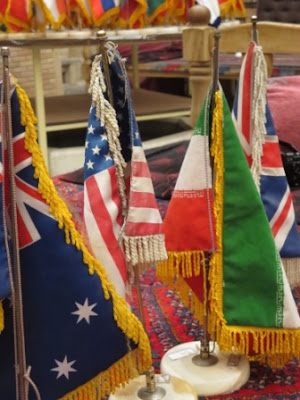After our walk through the alleys of Yazd, we packed up and drove about an hour to the Zein o Din Caravanserai which was south of Yazd on the Kerman highway. We timed our arrival for late afternoon as there was little to do at the caravanserai until evening.
Zein o Din was built over 400 years ago to provide rest and food for travelers and camels on the Silk Road. Nine hundred and ninety nine caravanserai were built across Iran, located 25 to 30 miles apart on trade routes that crisscrossed the country. Most caravanserai were built as square structures but Zein o Din is one of only two inns built in a circular shape.
After we put our luggage in our sleeping alcove, we climbed up steep stairs to enjoy the desert views from the roof. The sun setting over the distant mountains was a beautiful sight and one was reminded of the modern world only by the very faint sound of traffic on the distant highway about a mile off in the distance.
A wonderful meal was followed by an entertaining performance of fast and furious Baluchi dances. The spectators were sitting against the walls of the small room and I was sure the dancers would spin out of control and land on top of them in their exuberance. We returned to the roof after the dancing to gaze at the stars that appeared in our absence.
Zein o Din was built over 400 years ago to provide rest and food for travelers and camels on the Silk Road. Nine hundred and ninety nine caravanserai were built across Iran, located 25 to 30 miles apart on trade routes that crisscrossed the country. Most caravanserai were built as square structures but Zein o Din is one of only two inns built in a circular shape.
After we put our luggage in our sleeping alcove, we climbed up steep stairs to enjoy the desert views from the roof. The sun setting over the distant mountains was a beautiful sight and one was reminded of the modern world only by the very faint sound of traffic on the distant highway about a mile off in the distance.
A wonderful meal was followed by an entertaining performance of fast and furious Baluchi dances. The spectators were sitting against the walls of the small room and I was sure the dancers would spin out of control and land on top of them in their exuberance. We returned to the roof after the dancing to gaze at the stars that appeared in our absence.
The dark desert sky was a magical thing and we spent a couple of hours on the roof looking up at the stars, trying to identify the constellations. When we became too tired and cold to stay up any later, we went back down stairs to our beds. Our small sleeping alcoves were furnished with thin mattresses and pillows laid on plush carpets. It was a cozy spot and I imagined Silk Road traders being accommodated in much the same way. After breakfast we continued south to see some magnificent ruins of ancient Persia.


















































